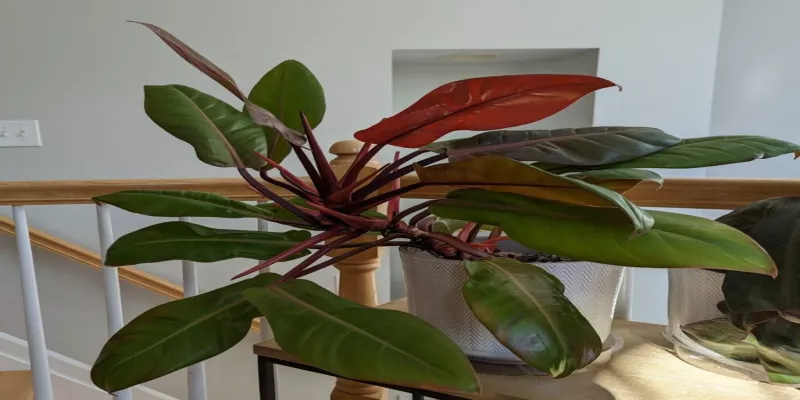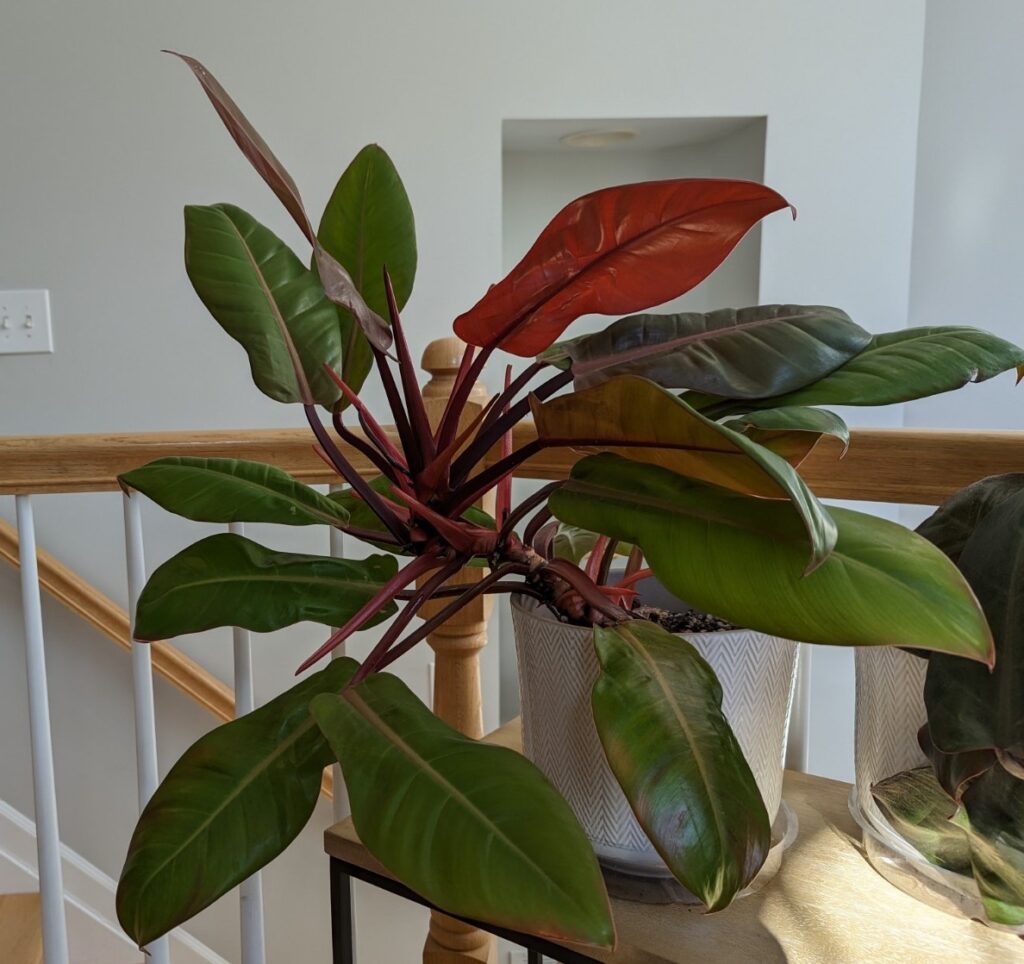Philodendron Prince of Orange Mature Size

Philodendrons are some of the most popular houseplants. They're typically readily available at many home improvement stores, your local nursery, and even the grocery store. Philodendrons come in a wide variety of shapes, sizes, and leaf patterns. If you live in growing zones 9-11, you can also grow them outdoors as a perennial plant. Today I'll be discussing Philodendron Prince of Orange mature size when grown indoors as well as my recommendations for caring for philodendrons, so they grow large.
Back to topPhilodendron Prince of Orange Mature Size
Prince of Oranges are self-heading plants and will eventually need something to grab onto to in order to grow tall. When climbing, the Prince of Orange can grow up to around three feet tall. The leaves of a Prince of Orange grow quite large and long. A mature Philodendron Prince of Orange may be as wide as two to three feet. My own Prince of Orange pictured below, which I just let grow wild instead of staking and climbing, is close to three feet in diameter at its widest point.

Mature Philodendron Prince of Orange Care
In my experience, the Prince of Orange easy to care for. The Philodendron Prince of Orange pictured above is one of the few Philodendrons I have, and it's about four years old now. I got it at a specialty plant shop with just a few tiny leaves and now it's grown significantly! For the quick basics on Prince of Orange care, check out the table directly below. I'll also go into more detailed care instructions in the rest of this post. Please note that the Prince of Orange is toxic to dogs and cats, so be mindful of where you place them and do not let your pets ingest them.
| Light Needs | Watering Needs | Soil Needs | Fertilizing Needs |
| Moderate to bright indirect light. | The top inch of soil should be dry before watering. | Well-draining potting soil. | A few times per growing season. |
Prince of Orange Light Requirements
Philodendrons are great indoor houseplants particularly because they do not require really bright direct light, which a lot of people struggle with in their homes. Out in the wild, philodendrons are more likely to be found under a tree canopy receiving dappled sunlight. The Prince of Orange is a hybrid, created by someone, not a particular variety that occurred naturally though. That said the Prince of Orange does need some sun, and hybrids like the Prince of Orange require a certain amount of sunlight to maintain their colorful leaves. If you notice that new leaves of your Prince of Orange do not appear orange, then it may need more light or it might be reverting. However, it is normal for the lower leaves to become green as the Prince of Orange matures though.
A Prince of Orange should grow well in an east or west-facing window. These windows provide some direct sunlight, but not the most intense, like you get from south-facing windows. If you do have a south-facing window, make sure there are some trees outside your window or you have a sheer curtain or your Prince of Orange may become sunburnt. If you're not sure which direction your windows face you should be able to tell by opening up a map app on your phone and using the compass.
My favorite plant tool for knowing whether your Philodendron is getting enough light, is this plant monitor. This monitor is great because it hooks up to an app that tracks the intensity of light all day giving you a readout of the accumulation of light and intensity. Most other affordable plant light meters on the market do not passively track information like that. As you can imagine it can be hard to get an accurate read on light accumulation that without a tracker because some days might be cloudy or overcast so it helps to have data for multiple days. I have a whole write-up on this meter in another post.
Back to topPrince of Orange Watering
Philodendrons are rainforest plants which means they like to have some moisture in their soil. From experience I know the Prince of Orange can tolerate some drying out though. I personally like to keep my plant soil a bit dry to prevent and combat fungus gnats, who really love moist soil. A frequently sited rule to follow is to check the top inch of soil with your finger to feel if it is dry before you water a Philodendron. Infrequent deep waterings are preferable over giving your Philodendron more frequent small sips of water. Deep watering will encourage the roots grow downward and the latter will result in shallow roots.
I personally don't like sticking my finger in the soil and having to clean dirt from my fingernail. I highly suggest a soil moisture meter. It's probably my most used plant tool. It has definitely helped me become a better at knowing how often to water and how much water to give each of my plants.
Back to topPrince of Orange Fertilizer
A Prince of Orange should be fertilized about every four weeks during the growing season. Generally, the growing season is considered to be late spring through early fall. Your Philodendron might put out some new leaves during the winter, but you still shouldn't encourage it because there's just not enough light for healthy foliage growth inthe winter.
The Prince of Orange does not require any specialty fertilizer. An all-purpose balanced fertilizer will work great and will help your Prince of Orange grow to a mature size in just a few years. A balanced fertilizer is one that has even, or very close to even, ratios of the three nutrients n-p-k. N-P-K is nitrogen-phosphorus-potassium. Nitrogen helps improve foliage growth and Philodendrons are leafy. However, I don't recommend using a nitrogen-heavy fertilizer unless you know your Philodendron has a nitrogen deficiency. You can check if your soil has nutrient issues by using soil rapitests, which measures the level of nitrogen, phosphorous, potassium, and pH separately.
Back to topPrince of Orange Soil
Prince of Orange Philodendrons do not require any specialty soil mix. All you need is a well-draining soil mixture. I typically start with regular potting soil and amend it with a little extra perlite. Perlite is the little white stuff you find mixed in most potting soils on the market. It's added to the prepackaged mixes to improve drainage. I usually like to add a little more mixing a 4:1 ratio of potting soil to perlite when I pot up my Philodendrons.
More important than the soil is what's holding the soil. Your Prince of Orange needs a pot that has drainage holes. A pot without drainage holes is asking for trouble with soil moisture. Philodendrons like some moisture, but a pot without drainage will be subject to rot. If you need to add drainage holes to your pot, follow my tutorial on drilling holes in ceramic and glass pots.
Have questions about mature Prince of Orange care? Let us know in the Comments section below.
Back to top
Add new comment